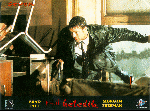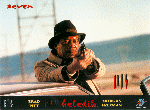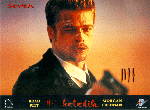
269 Kbytes
The dramaturgical structure of David Fincher's film brings nothing radically new as compared to the routine clichés of the genre. To be more exact, it is not the basic story itself which captures our interest but the up to now unknown causal interrelations of the well-known elements of the dramaturgy of thrillers, and, first of all, the very powerful visual world that portrays the story of the serial murderers on screen, and the weight of which is felt in an almost physical sense.
The configuration of the chess-pieces is a reflection of the initial steps of a classic game. A daringly ambitious young detective, and another one, just before his retirement, start pursuing the mysterious killer, as one of the heaven knows how many pairs of resigned-sanguine counterparts from among the long series of action films. The duo of Brad Pitt and Morgan Freeman, making an impressive début, draws the contrast of this much liked "positive-counterparts" even more striking. By the side of the black Somerset - a kind of father-figure, - and of the handsome Mills, there is of course a female character, in the role of the latter's wife, used to mitigate the two extremes. And there is even a further "main character", of the same rank as the previously mentioned ones, i.e. the City.
The metropolis, which came close to playing the title role in Fritz Lang's films and in the gangster movies of the 30s, is here a 20th century embodiment of Crime, Sodoma and Gomorra. With all its back-streets, actual and at the same time symbolic dead-end streets, dirty illuminated bars. The big city as portrayed on celluloid has perhaps never been more hostile and depressing than on the images of Seven, where, in order to enhance the stylised world of film noir, the scenes of crimes committed appear as horrific visions. Fincher, who formerly worked as a commercial and video-clip maker, portrays a disintegrating world with particular pessimism. Nowhere is there an encouraging light-effect or a "healthy" movement of the camera. It is an unusual vow for a Hollywood film-maker, not to plant the tiniest seed of humour or hope. His images of the city, captured by an aggressive camera and cut into very short pictures, are distorted into an even more chaotic shape by the grey curtain of rain, and as the background to an action-scene photographed from the fire-stairs we see black umbrellas passing by in the deep, and the Unknown's faceless figure is mirrored in a puddle. And in order to soak even the most dignified institution of the city in filth, as a culmination of visual effects, images of brutality are wedged into the image sequence of the library scene, accompanied by baroque harmony and lit by the light of green table lamps. The images of Sanctuary and of Hell crash frontally: The murderer draws "inspiration" from the works of Chaucer and Dante. Fincher, while amassing and enlarging the ominous effects of black film by way of light-dramaturgy and camera movements, works on to make us lose ground: in his nameless metropolis events take place within a single week (yet again a Biblical reference!), on any seven days torn out of Time and immediately following each other, in any major city of the world. To make us quite assured that Sin is omnipresent.
And to remind us that Seven wants to become the thriller of the decade at all costs. ("People will not believe what they see. They are going to bite their nails off" - these are the words producer Arnold Kopelson used to predict a safe future for the movie of pessimism). It is paradoxical that the reason why this is so obvious in the film is the otherwise praiseworthy pool of methods employed by the director and the cameraman. The film's most essential elements repeatedly express the intention of the film-maker, which is obvious, anyway. However, we would in all likelihood grasp our seats with the same convulsiveness even if what we saw was a less complete inventory of the methods of a thriller and we would probably highly appreciate a few indirect visual solutions. As a form of spiritual relaxation, between two blood-baths. We would feel compassion for the loneliness of our retiring detective, and we would understand the tense atmosphere created by slowly flowing time without seeing the slowly ticking metronome just as well. Similarly, there would probably be no question about the hopeless life of the Mills-couple even if the underground railway running close to their house did not cause a minor earth-quake. What is more, seeing these images, we would also be touched by the nihilism transposed from the director's Alien-interpretation (Alien 3.) if the discussion of our heroes about self-denial and indifference did not try to persuade us of its presence even with words. Because, who would expect deep-reaching philosophy from the detective of a super-thriller?
Anyway: hardly does this film need props like this. Fincher and his visual designers have managed to create images that speak for themselves. They literally revel in the naturalistic scenes depicting the results of the slaughters. They then shake us from our astonishment by overpowering scenes of pursuits, adhering to the basic law established in the golden age of the genre to a hundred percent, i.e. "the interest of the audience must be held all through". (Although the visual elegance and floating tension represented by the "legislator" Alfred Hitchcock have been systematically destroyed and ironed out by the action-thrillers of the 90s, Seven reminds the author of this paper the horizontal lines shifting to and fro, anticipating the atmosphere of Psycho. Since then, the random geometrical order has turned into total chaos, - this is the message of the letters of the main title, cut in the mode of clips, coming together with difficulty only and destined to disintegrate again. )
Under the effects of the pressure created by almost one-and-a-half hours of images of an apocalyptic world-end, we do not in the least mind that in the remaining time the makers of the film have employed dramaturgical turnings which urge us to do intellectual exercises. The rain stops, and the "stage-setting" of the closing scene is a barren desert instead of the thick, impenetrable city. The murderer is giving himself up to the police and, having taken vengeance for five deadly sins, wishes to complete his mission under police arrest. We have been waiting for this moment with him, i.e. for the moment when the battle is shifted from the realm of physicality to the realm of the psyche, towards "suspense". How are Envy and Anger punished? Is Fincher going to cut off the thread of tension injected into the so far dynamic images too early?
No, he does not.
Not even by the last image. A film constructed with complete Hollywoodian technology dares to leave the viewer alone in the closing scene with an anti-Hollywoodian ending. In Jonathan Demme's Oscar-winning Psycho-thriller the lambs became silent and the order of the world returned. Here, vengeance has been taken for all the seven deadly sins, yet even the promise of a completely modest happy-ending is light-years away. Because, if you really think it over, a logical error skips into the seemingly systematic theory adopted by our serial killer: in the end, sin is not turned only against the sinners. It is to be admitted, however, that we are compensated for this dramaturgical inconsistency with nerve-racking minutes. Furthermore, it is not to be denied that Fincher's The Seventh, being not entirely without greediness and haughtiness - a film which in Hungarian movie-theatres, true to good style, is presented from 7th November on, - will continue to be a success of the genre for a long time. The film is one of the "well-constructed" Hollywood products, which inspires neither envy nor anger in the critic.

258 Kbytes

203 Kbytes

203 Kbytes

